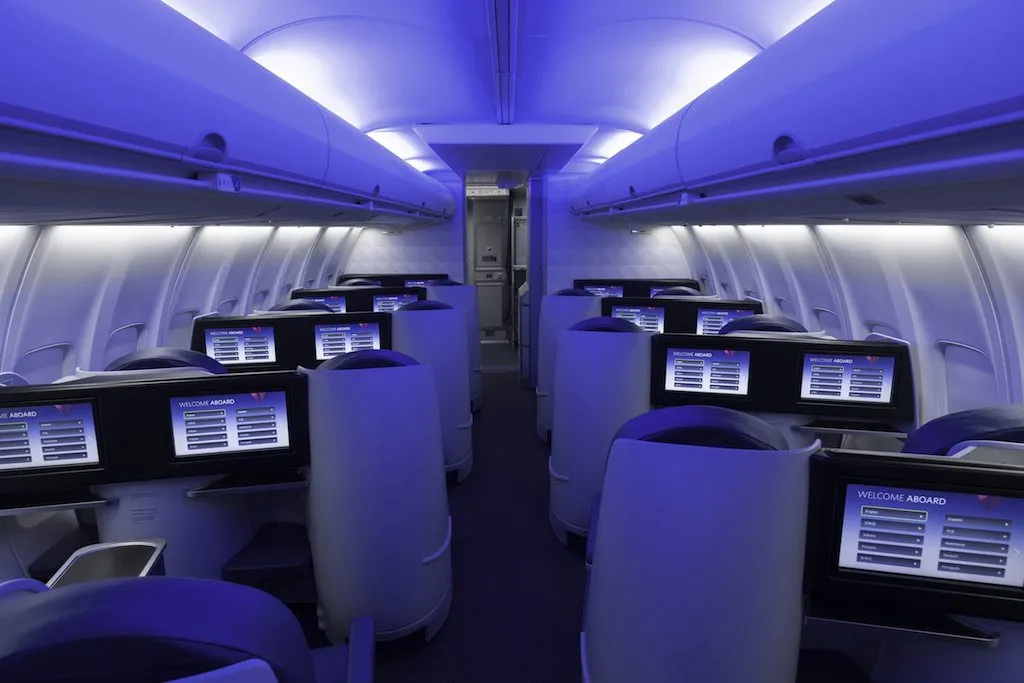Delta Puts a Better Business Class on Routes Where Travelers Will Buy It

Skift Take
U.S. airlines usually follow a formula when deciding which routes fly with premium cabin configurations.
If a plane crosses an ocean, the airline offers generous seating, usually with flatbed seats. Within North America, with a few exceptions like flights from New York, passengers only get a few extra inches of legroom and a wider seat.
This makes sense for operational reasons. Airlines prefer to reduce complexity; keeping international products and service separate is efficient. Plus, it helps with marketing because passengers know what to expect when flying anywhere in Europe.
Commercially, however, it's an odd strategy. Tourists don’t buy many flatbeds to some European tourist destinations, including secondary airports in Spain, Portugal, and Ireland. But business travelers on longer U.S. routes might want them — if they were for sale.
Slowly, airlines are changing their strategies.
This weekend, Delta Air Lines announced it will add flatbeds to several domestic routes this spring, while removing them from a few international ones. Delta will no longer offer its swanky Delta One cabin from Minneapolis and New York to Keflavik International Airport in Iceland, or from New York to Shannon, Ireland or Ponta Delgada, Portugal. Instead, those routes get regular domestic-style first class seats branded as premium economy.
Domestic routes slated to get the long-haul-style product include New York to San Diego and Las Vegas, Honolulu to Minneapolis and Atlanta, and Boston to Los Angeles. Not every flight each day will have Delta One, however.
The routes will join several other domestic Delta One flights, such as New York to San Francisco and Los Angeles, and Washington, D.C. to Los Angeles.
“It makes perfect sense if you have the flexibility to properly configure certain subsets of fleets and isolate them to demands and routes where those configurations produce the best revenue,” said Robert Mann, an aviation analyst and consultant.
Delta has advertised its changes more than other airlines, promising they'll receive Westin Heavenly In-Flight bedding, Alessi silverware, and some other goodies, but it’s not the only U.S. carrier expanding premium routes.
American and United increasingly fly aircraft equipped with flatbeds on longer domestic routes, calculating customers will pay for better seats. Often, though, when American and United fly a long-haul plane domestically, they don’t load amenities like bedding, amenity kits, and improved food. Passengers get a better seat, but not much else.
American and United may copy Delta and improve service on some high-revenue domestic flights, but in emails, spokesmen for the two carriers declined to share their airline's plans. United recently upgraded Boston-San Francisco to a proper premium flight, but it's not clear if plans to add more.
Why are airlines doing this?
In shifting more comfortable aircraft to U.S. routes, carriers are chasing business travelers who might buy first class for a better product.
But they’re also reacting to a new player — JetBlue Airways. Over the past three years, JetBlue has added its flatbed product, called Mint, to many routes that never had been considered worthy of one.
Mint not only flies from New York and Boston to San Francisco and Los Angeles, but also from the East Coast to Las Vegas, San Diego, and Seattle. Additionally, Mint flies from San Francisco and Los Angeles to Fort Lauderdale.
“It's unclear to me whether this is smart use of capacity for Delta or if it's simply, ‘JetBlue is doing something, we need to stop them,’” Brett Snyder, an airline analyst and blogger, said in an interview. “Delta is sitting on top of JetBlue on these routes. This is probably not something they would do otherwise.”
Snyder said he doesn't know whether the new premium Delta routes will make money. San Diego might be a better place to put a premium airplane than Shannon, but that doesn’t mean it’s an obvious winner.
“New York to L.A. and San Francisco is far and away the biggest domestic market for premium cabin travel,” Snyder said. “Everything else would be a leap of faith. JetBlue took that leap and apparently is finding it a nice place to be.”
Will more airlines remove business class to Europe?
If airlines expand premium cabins on domestic routes, they need to get the airplanes from somewhere. That means it’s possible more carriers may join Delta in removing them from shorter European routes, where premium seats do not sell well.
Air Canada has already proven there’s a market for all-economy class transatlantic aircraft. About four years ago it introduced a new airline named Rouge to fly Boeing 767s configured without business class to low-premium demand destinations like Budapest, Glasgow, Manchester, and London Gatwick. Passengers can book nothing more luxurious than premium economy.
U.S. airlines haven’t copied Rouge, because they don’t like the complexity of running two brands at the same time. But they have faced the same issues as Air Canada. Some European routes popular among tourists don’t require 30 or more flatbed seats.
U.S. airlines can keep keep upgrading lucky passengers to Dublin or Shannon in July, or they might follow Delta and experiment by sending aircraft configured for domestic routes.
This summer, United will send a Boeing 777-200 in what it has called a domestic configuration to Dublin. It’s a plane loaded with 336 coach seats, but with only 28 flatbeds in business class. United flew essentially the same 777 with 50 seats in business class and 217 in economy last summer. It was not the optimal configuration for a leisure-heavy market.
“You look at this airplane, with a small premium footprint and a ton of coach seats, and it makes sense in these high leisure markets in the summer,” Snyder said.




